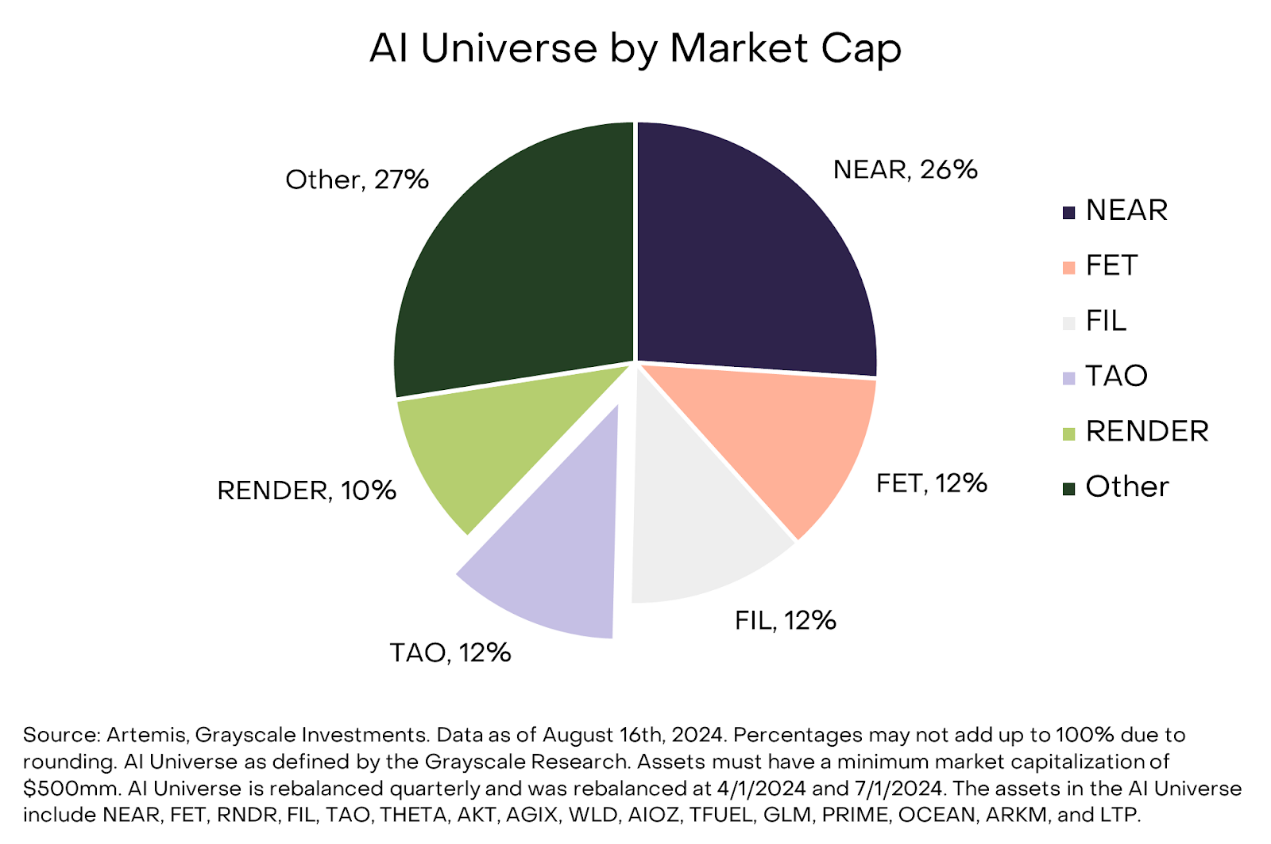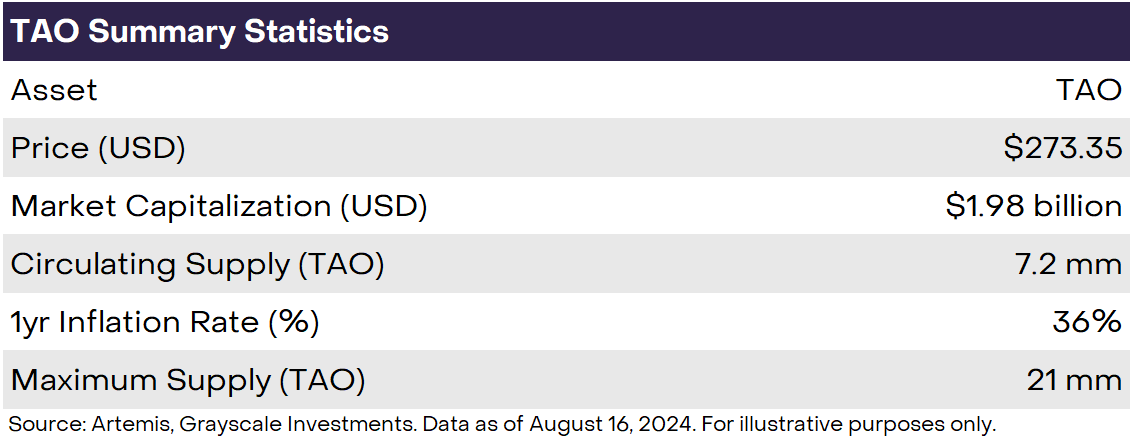Bittensor is a platform that promotes the development of open and global AI systems through the use of decentralized networks and economic incentives.
Authored by: Grayscale
Translated by: Felix, PANews
Summary
Bittensor stands at the forefront of the two most groundbreaking and transformative trends in the software field: blockchain and artificial intelligence (AI). While Bitcoin helped create the cryptocurrency industry as the first peer-to-peer currency system and digital value store, and Ethereum expanded the ecosystem through decentralized applications, Bittensor represents a new and unique use case. It plans to leverage the characteristics of permissionless public blockchains and economic incentives to develop advanced AI software through an open, decentralized community (not a centralized company).
Today, the development of AI is highly concentrated, with a large amount of power held by a few major tech companies. As AI becomes a more powerful and important tool, there is a risk of it being controlled by a few entities, which contradicts human values and broader society. In contrast, Bittensor is a platform that incentivizes open collaboration in AI development through its native token TAO. By using public blockchains, Bittensor may contribute to democratizing ownership, increasing transparency of AI systems, and aligning decision-making in AI development with societal interests. Bittensor aims to create an "AI internet," envisioning a future with many interconnected AI ecosystems or subnets, forming a global decentralized AI platform. By connecting to the Bittensor network, the platform will help anyone easily build, deploy, and access AI applications anywhere.

Chart 1: As of August 16, TAO accounts for 12% of Grayscale's AI domain
Token
TAO is the native token of the Bittensor network, and owning TAO tokens represents ownership of a part of the ecosystem (Chart 2). The supply plan for TAO is fully consistent with Bitcoin, with a maximum supply of 21 million tokens, halving approximately every four years. Bittensor's first halving event is expected in August 2025.
Bittensor aims to apply Bitcoin-style incentives to AI development, using TAO tokens as incentives for network participants to perform their intended functions. These participants include network validators and subnet owners, subnet validators, and subnet miners. In addition to incentive rewards, TAO is currently primarily used by subnet owners to register deposits for their subnets. In the future, as the nascent Bittensor network matures, potential additional use cases for TAO include (i) serving as gas fees for network transactions, (ii) serving as decision-making power for allocating TAO issuance to subnets, and (iii) general network governance decisions. In the long term, Bittensor may monetize the network by charging end users of applications that use its subnets, which could generate value for the TAO token.

Chart 2: Basic information about the TAO token
Network and Technology
On Bittensor, developers compete to create the best AI models in exchange for TAO rewards. The system supports a range of AI-related services, including chatbots, video generation, deepfake detection, storage, and computation. To democratize AI development, Bittensor allows AI researchers and independent open-source developers to monetize their innovations and potentially contribute to a more equitable distribution of AI benefits.
Bittensor employs various subnets specifically designed for different machine learning tasks. For example, one subnet is dedicated to AI image generation, another for AI music generation, and another for detecting AI-generated deepfakes. Each subnet involves three main types of participants: subnet owners, subnet miners, and subnet validators. On a given subnet, miners compete to produce the "best" output, while validators assess which miners perform "best" (see below). While the specifics of this process vary by subnet, the overall approach is outlined as follows:
Operation
End users prompt the network through consumer-facing applications, similar to querying ChatGPT.
Subnet miners run AI models on the relevant subnets and compete to generate the best output for a given prompt. For example, in the chatbot subnet, miners would compete to provide the best answers to user questions.
Validators rank the responses of miners based on output quality and return the highest-ranked response to the prompting end user.
Validators determine miner performance through a new process called Yuma consensus. This consensus mechanism aggregates rankings from each validator and weights them based on the amount of TAO they have staked to generate a collective ranking of miner performance.
The broader Bittensor blockchain operates under an "authority proof" consensus mechanism, where certain nodes are granted permission to order on-chain transactions and help maintain network integrity. Bittensor's block storage updates state changes and token balances to reflect new releases by network validators, subnet owners, miners, and validators.
Use Cases
Bittensor has a wide range of potential use cases, with each subnet representing a different example. These include:
Image Generation Subnet: Tailored for AI models specifically designed to create high-quality generated images.
Chatbot Subnet: Optimized for AI models specifically designed for natural language processing, allowing consumers to access a responsive virtual assistant.
Deepfake Detection Subnet: Utilizes advanced generation and discrimination AI models in the Bittensor network, aimed at detecting AI-generated images.
In the decentralized AI solutions in the cryptocurrency field, Bittensor's several direct competitors are comprehensively addressing AI development issues. For example, the Allora network focuses on AI development in the financial services sector, providing an automated trading strategy platform for decentralized exchanges and prediction markets. Other early projects attempting to address decentralized AI issues at the infrastructure level include Sentient and Sahara AI.
In addition to these direct competitors, certain protocols also compete with specific Bittensor subnets. For example, Akash competes to some extent with the computation subnet, Filecoin competes with the data storage subnet, and Gensyn competes with the pre-training and fine-tuning subnet. However, some prominent AI companies (such as Wombo and MyShell) and crypto teams (such as Masa, Kaito, and Foundry) have already established their own subnets.
Considerations
Growing market opportunities: The market size of centralized AI is estimated to reach $215 billion in 2024, with an expected compound annual growth rate of 35.7%. Grayscale believes that Bittensor represents a new and unique use case in the cryptocurrency space. The valuation of decentralized AI is only $19 billion, reflecting its early stage. In an era where a few tech companies seem to control AI, Bittensor represents an early investment at this intersection.
Development and use of powerful technology without permission: As AI continues to evolve into a more powerful and important tool, there may be increasing regulations or restrictions on who can build or access these applications. Bittensor provides an alternative by offering access to resources for developing and using AI without permission.
Promoting Fair AI Development through Economic Incentives: Compared to centralized alternatives, Bittensor can help independent AI developers access AI resources such as computing, storage, and data more. It can also help AI researchers and open-source AI developers monetize their contributions and potentially fund their operations. If successful, Bittensor's open and distributed ecosystem can help balance the closed-source models developed by tech giants and contribute to ensuring a more widespread sharing of the economic benefits of AI.
Increasing Popularity and Recognition: Bittensor has garnered early attention, with over 40 subnets dedicated to specific AI tasks and recognition from prominent tech and AI leaders. The company is raising venture capital to build subnets and applications on Bittensor, indicating increasing interest from investors and developers in the ecosystem, and the potential for Bittensor to expand its network effects.
Investment Risks
Adoption and Network Growth: The lifespan of Bittensor depends on attracting a large number of developers and AI projects to build on the platform. If Bittensor fails to achieve widespread adoption, the network may struggle to reach its full potential. Additionally, given the network's nascent stage, most network resources are concentrated at the infrastructure level and subnet activities. Over time, Bittensor needs to increase the number and quality of application end users to help enhance token value accumulation and its relevance to everyday consumers.
Degree of Decentralization and Network Resilience: Bittensor's operations depend on the smooth functioning of a widely distributed network of participants. Any disruptions, such as technical failures, errors, or network attacks, could impact its performance and reputation. Bittensor also needs to enhance the overall degree of network decentralization and more widely distribute voting rights for TAO releases across the network.
Implementation of Incentive Design: To fully realize its potential, Grayscale believes that Bittensor needs to ensure that subnet owners design the right incentive mechanisms for their subnets and ensure that the network appropriately allocates releases to suitable subnets over time.
Competing Networks: Bittensor faces competition from AI-related crypto assets that attempt to address AI development issues through token incentive measures, such as Allora, Sentient, Sahara AI, and other assets covering various AI-related use cases, including Filecoin and Gensyn. As this intersection matures, this list may also grow over time.
免责声明:本文章仅代表作者个人观点,不代表本平台的立场和观点。本文章仅供信息分享,不构成对任何人的任何投资建议。用户与作者之间的任何争议,与本平台无关。如网页中刊载的文章或图片涉及侵权,请提供相关的权利证明和身份证明发送邮件到support@aicoin.com,本平台相关工作人员将会进行核查。




